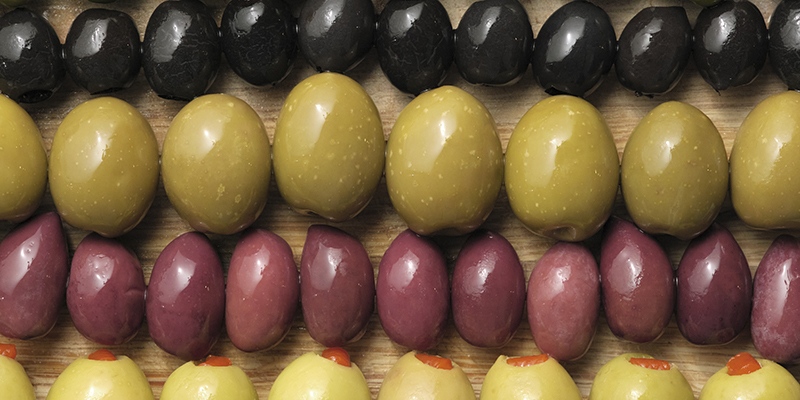
The choice of olives can sometimes feel overwhelming: Do you want pitted or whole olives? Bitter or sweet? Should you pick black or green olives – and what’s the difference anyway? Our beginner’s guide to olives answers your most pressing questions, and introduces some of our favourite olives and how to use them.
Are fresh olives better than jarred olives?
Fresh olives glistening on the deli counter might look very appealing, but they’re exactly the same as the good quality olives you’ll find in jars. The only difference is that the jarred olives will keep longer and they’re usually more cost effective too. Deli olives might feel like a treat, but you’re better off buying better quality jarred olives for less.
What’s the difference between green and black olives?
The colour! That’s about it. Green and black olives are the same fruit; black olives are simply left on the tree to mature for longer and change to a darker purple-black colour. Just like red, green, yellow and orange peppers all come from the same plant at different points of ripeness. Some black olives like Hojiblanca are picked whilst they’re still green, and then turned black as part of the curing process using lye, oxygenated water and a stabiliser called ferrous gluconate to fix the colour. Processed black olives aren’t as nutritious or complex flavoured as naturally black olives like Kalamata, but their mass production does make them cheaper. Premium olives like our like Alexandria style olives or green Conservolia olives are usually just cured in brine and packed unpasteurised in oil.
Are olives good for you?
Olives don’t just taste good, but they do you good too. This humble little fruit is high in vitamin E and phytonutrients, which has been linked to reducing cancer risk, and they have anti-inflammatory benefits and oleanolic acid which is good for heart health. Unprocessed olives are also high in polyphenols. Usually the stronger and more pungent the taste, the higher the polyphenol content. Because they’re often preserved in brine, olives can be high in salt so a portion of olives is recommended to be 15-20g, which is about six olives per adult. If they’re eaten in moderation, with mixed grains or as part of a colourful green kale salad, olives form an essential part of a healthy, balanced diet. TIP: put olives in your salad or pasta dishes instead of using salt!
The ultimate olive guide
There are as many olives in the world as there are recipes to use them, but similar to how wine has different grape varieties like Riesling, Merlot or Chardonnay, so do olives. Whatever you’re serving in the kitchen, you can guarantee there’s an olive for that.
Here’s our guide to some of our favourite olives and how to recognise them – and most importantly – how to eat them.
Kalamata olives
Best for: Greek salad
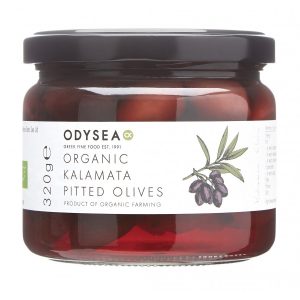
A naturally black olive with a distinct tear-drop shape, Kalamata are unique to Greece and harvested in December when fully ripe to get that deep purple colour and fruity flavour. Single estate olives (much like single estate chocolate or coffee) means all the olives come from one producer’s crop, which is a real guarantee of quality. Our single estate organic Kalamata olives are harvested, naturally cured and packed by hand in the Rovies grove on the Greek island of Evia. They’re slightly more bitter than lye-treated black olives, but they also bring a lot more complexity under their plump, shiny skin. Try our juicy, big kalamata pitted olives or bake them into traditional Greek olive bread to get a taste of why Kalamata has been crowned the Queen of Greek olives.
Conservolia olives
Best for: All rounder
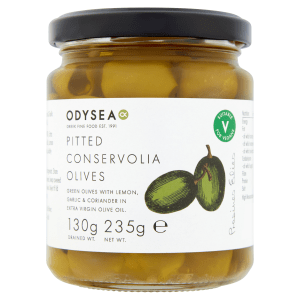
If you’re looking for a multipurpose olive, put a jar of Conservolia in your shopping trolley. With a firm texture they stand up to cooking in a tagine or gentle stew, but they also perform well in a salad or as a cocktail nibble. Conservolia hold flavour beautifully in our sweet chilli and cumin Alexandria style olives and our cracked green olives with lemon slices, pickled garlic and coriander seeds. Our top tip is to always use the oil from these marinated olives; shake it up into a dressing, drizzle over bread, or bake it into an Olive oil focaccia.
Big Halkidiki Pitted Olives
Best for: Casseroles
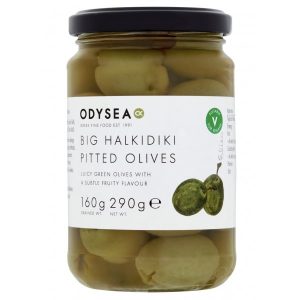
These large pale green Greek olives are harvested while young in October and have a soft, peppery flavour. They only grow in the Halkidiki peninsula of northern Greece near Mount Athos, and their firm texture and size means these pitted olives are easily stuffed with soft cheese, slivers of almonds, or sundried tomatoes.
Nocellara olives
Best for: Nibbles
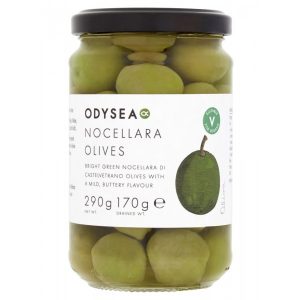
Buttery, mild and slightly sweet, Nocellara olives are perfect for laying out with other nibbles and a drizzle of olive oil. Our Nocellara olives come from the Castelvetrano region of Sicily. The olives are hand harvested at the beginning of the season from late September whilst they are still young and bright green. Because of their unique processing method these olives are not fermented and can oxidise quickly once opened, so keep them covered in brine to preserve their colour and firm bite. This is the perfect ‘beginners’ olive thanks to it’s mild and slightly sweet flavour.
Hojiblanca olives
Best for: Pizza
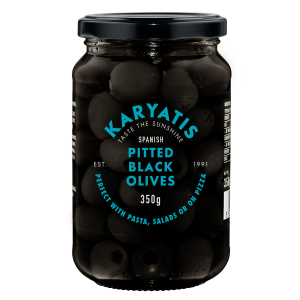
The workhorse of the olive world, these little pitted olives are perhaps the most common olives you’ll see adorning bar tables, pasta and sauces. Grown in Andalusia they undergo the Spanish lye-cure oxidising method to achieve a uniform dark black colour, rather than leaving them to ripen on the trees. This is quicker than leaving the olive to ripen on the tree and is why they’re usually the lower priced olives on the shelves. Hojiblanca means ‘white leaf’ named after the tree’s silvery leaves, and they have a firm bite and straight forward bittersweet taste.
Manzanilla olives
Best for: Martini
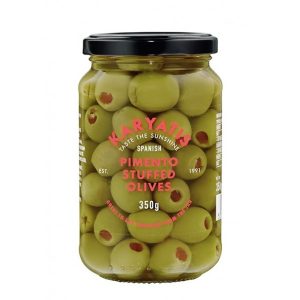
Similar to Hojiblanca olives, Manzanilla green olives grow in abundance and are the most popular olives from Andalusia, Spain. Packed in a light brine, they’ve got a slight saltiness with a plump and firm bite that makes them incredibly versatile. Pimento stuffed Manzanilla olives are the perfect martini olive, and the flash of red looks great in a salad too.
Did you go for a martini or a mixed salad? Share your favourite olive recipes with us on social media by tagging @Odysea_Ltd or using #feedingconversation. We’d love to see what you’ve picked!